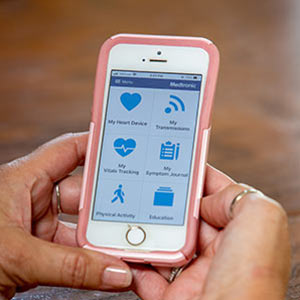Valerie’s Story
Valerie was one of the first patients in Michigan implanted with a Bluetooth-enabled ICD.
 Valerie Satterfield thought she had the flu. The diagnosis of cardiomyopathy, or a weak heart, from her primary physician was not at all what Valerie expected. Her next visit was with a local cardiologist who helped manage Valerie’s symptoms with medication.
Valerie Satterfield thought she had the flu. The diagnosis of cardiomyopathy, or a weak heart, from her primary physician was not at all what Valerie expected. Her next visit was with a local cardiologist who helped manage Valerie’s symptoms with medication.
A year later, Valerie began experiencing a lot of dizziness, extreme fatigue, and had three episodes where she completely collapsed. That’s when Valerie’s cardiologist in Monroe, Michigan, decided it was time for her to see a cardiac electrophysiologist, a doctor who specializes in the electrical function of the heart. She was referred to Arfaat Khan, M.D., Henry Ford Hospital's Director of Electrophysiology.
Valerie was one of the first patients in Michigan implanted with a Bluetooth-enabled ICD.
Valerie has what Dr. Khan explains as Atrial Fibrillation or AFib. It is the most common heart arrythmia in the world. It causes the top chambers of the heart, call the atria, to beat erratically--it feels like your heart is racing or fluttering. A normal heart beats at 60-90 beats per minute, but a heart in atrial fibrillation beats at over 500 beats per minute. Symptoms of atrial fibrillation can be different for each person: Some people have no symptoms and others are diagnosed only after a stroke. Valerie also had a heart condition called cardiomyopathy, or a weak heart, which places her at a higher risk for sudden cardiac death.
To ensure that Valerie’s heart never goes into cardiac arrest--or causes a death episode--Dr. Khan recommended that she use an implantable cardioverter defibrillator or ICD , to constantly monitor her heart’s rhythm. It’s there preventatively: If the heart’s rhythm gets out of sync, the ICD will send an electrical impulse to the heart to put it back into proper rhythm, sometimes without the patient even being aware.
 While ICDs have been used for decades, Valerie was one of the first patients in Michigan to receive a Bluetooth®-enabled ICD. She says she was initially afraid, but not for the reasons one might expect. True, she was one of the first patients to use it, and the non-invasive procedure to implant it did involve a small puncture, but her fears were tech related. “I’m not very technologically savvy, that part scared me,” Valerie says. “But it turns out the app was very easy to operate. I didn’t even need my kids to show me how to make it work!”
While ICDs have been used for decades, Valerie was one of the first patients in Michigan to receive a Bluetooth®-enabled ICD. She says she was initially afraid, but not for the reasons one might expect. True, she was one of the first patients to use it, and the non-invasive procedure to implant it did involve a small puncture, but her fears were tech related. “I’m not very technologically savvy, that part scared me,” Valerie says. “But it turns out the app was very easy to operate. I didn’t even need my kids to show me how to make it work!”
The benefits of the Bluetooth®-enabled ICD are many. The app on Valerie’s smart phone allows her to send a direct message to Dr. Khan and his team—or, if Valerie isn’t able to, the app will send him an immediate alert. Both Dr. Khan and Valerie can monitor her heart and health at all times.
Valerie is a very active person. She loves swimming and walking around her family’s Christmas tree farm. “The app shows me what my exercise level has been for the day, and monitors the life of my battery. It even sends a message if I’m not sure what’s happening to me,” Valerie says. “I’m grateful that I don’t have the big, bulky transmitter that’s used with older ICDs. I can travel anywhere and it’s all on my phone.”
Valerie is feeling very positive about where life is going since her Bluetooth-enabled ICD was implanted and is thankful for the convenience and simplicity it gives to her life.
We use cookies to improve your website experience. By using this site, you agree to our Terms of Use. Read our Internet Privacy Statement to learn what information we collect and how we use it.